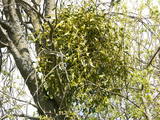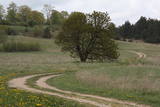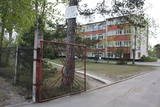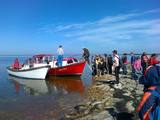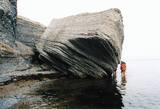| Nr | Name | Beschreibung |
|---|---|---|
|
Opekalns (arī Apukalns, Opekols) ir paugurs Alūksnes augstienē, 235 metrus virs jūras līmeņa, Veclaicenes pauguraines viena no augstākajām virsotnēm. Tā virsotnē uzcelta Opekalna luterāņu baznīca (1774—1779), kas ir visaugstāk virs jūras līmeņa novietotais dievnams Latvijā. Opekalna ciemā dzimis leģendārais Dziesmu svētku virsdiriģents Haralds Mednis. |
||
|
Der Bau der Burg wurde vom Schwertbrüderorden 1207 angefangen, aber 1236 umgebaut und auf Bedürfnisse des Livländischen Ordens angepasst. Die Burg wurde im Laufe der Kriege in den 16 – 17 Jh. sehr zerstört. Heute ist die Burg restauriert. Von einer Freilichbühne öffnet sich einen schönen Blick aufs Gauja-urstromtal. |
||
|
Die Umgebung von Tērvete ist bekannt für ihre Burghügel, die Märchenfiguren der lettischen Schriftstellerin Anna Brigadere, deren Skulpturen im Park zu finden sind, seinen alten Nadelwald, das Dendrarium, das historische Museum von Tērvete, den Aussichtsturm, die Landschaft uvm.
|
||
|
Der Apakšceļš (der untere Weg) - ein einsamer Weg, der durch die Wälder und
Moore zwischen Košrags und Dūmelis verläuft, mit dem viele interessante Fakten
zusammenhängen: die Mühle von Pitrags, die niemals in Betrieb genommen
wurde (es sind noch Reste von der Aufschüttung zu sehen); der Dampfkessel von
einem verunglückten Schiff, den der örtliche Baron zum Teerbrennen benutzt hat;
die ehemalige Pferdestraße, die durch das Bažu Moor verlief und der markante
Stein von Dūmele.
|
||
|
Das ist ein bewaldetes Territorium, wo auf einem der größten Gebiete die Weißbeerige Mistel, ein Halbschmarotzer, zu finden ist. Am besten kann man diese einzigartige Pflanze wahrnehmen, wenn sie keine Blätter hat. Lettland ist die nördliche Grenze für die Weißbeerige Mistel, man findet sie nicht überall.
|
||
|
Ein geschütztes Territorium mit einer Reihe von künstlichen Teichen im Südwesten von Saldus. Die Teiche ziehen viele verschiedene Vogelarten während der Nist- und Vogelzugzeit an. Der Ort wurde nicht für touristische Zwecke aufbereitet, trotzdem ist es ein interessanter Ort zur Vogelbeobachtung. In den Wäldern um die Teiche sind auch viele geschützte Vögel und Fledermausarten beheimatet.
|
||
|
Im Garten der schönen und praktischen Ideen kann man das ganze Jahr über prächtige Blumen und eine große Kollektion Nadelgehölz bewundern. Hinter dem Haus befindet sich der Wirtschaftsbereich mit Gemüsebeeten und Gewächshäusern. |
||
|
1,7 km gara lokveida taka, kas iepazīstina ar dažādiem meža biotopiem, to iemītniekiem un meža apsaimniekošanas pamatprincipiem. Apmeklētāju ērtības nolūkā ir izveidotas koka laipas un neliels skatu tornis. |
||
|
Atrodas Skolas ielā 12, Priekules pamatskolā. Tās krājumā ir plašs Priekules novadā iegūto vēsturisko liecību klāsts – sadzīves priekšmeti, darbarīki, dokumenti, padomju gados izsūtīto un represēto cilvēku atmiņu stāsti u.c. liecības, kā arī Priekules skolu attīstības vēsture. |
||
|
Zur Zeit befindet sich die Grundschule 3 im Platz, wo früher die Autoschule der Seestreitkräfte von Karaosta in Liepāja war.
|
||
|
Im Wald von Kaltene ist ein sagenumwobenes Naturwunder – Kalvas von Kaltene bzw. von Valna zu besichtigen. Das Entstehen dieser Anhäufung im Wald, 2 – 3 km von der Küste entfernt ist mit den Küstenbildungen des Baltischen Eissees verbunden. Die größte Anhäufung ist Velna kalva (Teufels-Kalva). Seinerzeit war Velna kalva eine schöne Anhäufung, so große, dass “sich bis Gipfeln der Bäume streckte”. Auf den früheren Karten wurde die absolute Höhe dieser Anhäufung angegeben – 20 m. Diese Anhäufung bestand aus Steinen verschiedener Formen. Die Steine waren sowohl voll kugelförmig als auch in einer Tellerform. Diese Anhäufung wurde fast vollständig in den 1960er – 1970er Jahren vernichtet, da daraus die Schotter für Straßenbau gewonnen wurde. Heutzutage ist nur ein ziemlich kleines Fragment des Unterteils von Kalva erhalten geblieben. Die Länge dieses Fragments beträgt ca. 300 m, aber die Höhe – 2 m. Die Wissenschaftler äußern eine Meinung, dass diese Anhäufungen im Altertum Sakralorte sein könnten, da viele Sagen und Legenden sind darüber geblieben. Um die Anhäufung zu besichtigen, wurde einen Naturpfad mit den Informationsständen und einem nicht großen Parkplatz errichtet. (Die Quelle: Roja TIZ) |
||
|
Befindet sich im Zentrum von Ineši, 5km südlich von Vecpiebalga. Die Anfänge dieses Herrenhauses sind von zweiten Hälfte des 17. Jh. bis zum 19. Jh. zu suchen, als 1786 am Ufer des Flüsschens Orisāres (andere Schreibweisen: Orizāre, Arisa) das Schloss des Grafen Scherementjev im klassizistischen Stil erbaut wurde. Während der Aufstände 1905 wurde es heruntergebrannt, vier Jahre später wieder aufgebaut. Das Gutsgelände umschließt ein Landschaftspark im symmetrischen Konzept eines Barockgartens. Der Gutshof von Vecpiebalga diente in dem berühmten Roman der Gebrüder Kaudzīte als Prototyp für den dort beschriebenen Gutshof Slātava. Im Weinkeller des Gutes wurde 1992 das Heimatmuseum von Piebalga eingerichtet. Im Herrenhaus hat auch der Ortsrat von Inesi seinenSitz, außerdem gibt es hier ein Studio für Porzellanmalerei. Interessenten werden organisierte Besichtigungstouren im und um den Gutshof angeboten. |
||
|
Ziel des Museums ist die Verbreitung von Kenntnissen über das lettische Dorf, die Entwicklung der Landwirtschaft im Land ausgehend vom Ende des 19. Jahrhunderts bis in die heutige Zeit. Das Museum bemüht sich, dem Besucher die verschiedenen landwirtschaftlichen Arbeiten und Techniken nahezubringen, vom Pflügen über die Ernte bis hin zur Weiterverarbeitung. Dazu werden zahlreiche Werkzeuge und Geräte gezeigt. |
||
|
The museum offers information about local manufacturing traditions, as well as products from SIA Naukšēni – various oils (made of rapeseed and hempseed), ten non-alcoholic beverages (kvass, mineral water), as well as tastings of homemade wine. Some of the products can be purchased. |
||
|
Das Restaurant befindet sich in der Altstadt von Liepaja, in einem restaurierten Gebäude, wo der Postbote Arvids gelebt und seine Tage verbracht haben soll. Das Gebäude hat Auszeichnungen für seine Innenausstattung erhalten. In der Speisekarte ist attraktiv das Leben des Postboten Arvids geschildert worden, dem Sie glauben oder nicht glauben können... Lettische Küche: Kalte Suppe, Ampfersuppe, im Ofen gebackener Kabeljau, Wels- und Flunderfilet, gegrillte Schweinerippen, Graupengrütze in Speck- und Zwiebelsoße, Kartoffelpfannkuchen, dünne Pfannkuchen, geschichtetes Roggenbrot-Dessert. Das besondere Gericht: Liepājas menciņi (Kabeljau von Liejapa) geräucherter Kabeljau mit Kartoffeln, Zwiebeln und Dillen in einem Keramiktopf. |
||
|
Alltägliches Leben und Bauernarbeit, Schaffarm mit tollen estnischen Schwarzkopfschafe. Auf altertümlichen Kulturpfad (Steingräber, Felder, Heide) erfahren sie mehr von den altertümlichen Esten und Geschichte des Bauernhofes. Am Hof beschäftigt man sich mit Handarbeit, auch die Gäste haben die Möglichkeit etwas aus Wolle zu basteln. |
||
|
Das Denkmal für die Befreiung von Lettgalen Vienoti Latvijai (Vereinigt für Lettland). Nach den zwei Versuchen, das Denkmal zu demolieren, wurde es am 13. August 1992 gebaut. |
||
|
Der Unternehmen bietet auf Indrl Saaremaa unterschiedliche Naturtouren zum Kennenlernen der Natur-und Kulturerbe: Robbenbeobachtung, Naturwanderungen zu Fuss oder mit Fahrrädern, Skitouren, Schlauchboottouren zu den Holmen im Nationalpark Vilsandi,Orchideetouren etc. Im Waldpark Miku im Nationalpark Vilsandi kann man Forstarbeit beobachten und auch selbst ausprobieren. |
||
|
Arī 18. novembra laukums. Tas sācis veidoties 18. gadsimtā kā tirgus laukums. Tā dominantes bija 1752. g. celtais rātsnams (nav saglabājies) un aptieka, kas šajā ēkā darbojas no 1810. g. līdz pat mūsdienām. 2010. gadā laukumā izveidota strūklaka, kam ir pilsētas ģerboņa forma. |
||
|
There are two islands here – Suur Pakri (Great Pakri) and Väike Pakri (Small Pakri). They are 3 km to the West of Paldiski. During Soviet times, the islands were used for target practice by the Soviet air force, which is seen in the many craters and spent munitions that can be found on the island even today. The island is mostly covered with scrappy areas of juniper, but the limestone cliffs at the northern and north-eastern end of the island are quite impressive – as much as 6 m in height.
|
||






